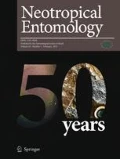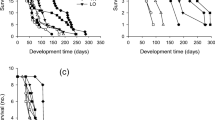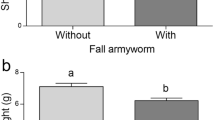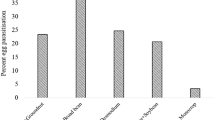Abstract
This study compared the development of fall armyworm, Spodoptera frugiperda (J.E. Smith) (Lepidoptera: Noctuidae), on forage species of different genera (Arachis, Axonopus, and Cynodon) in relation to maize (preferred host) as well as its adaptability on these forage species, which are the main cultivated forages in southern Brazil. The biological performance of S. frugiperda fed on host plants studied showed the highest adaptation index (AI) in maize (26.89), followed by bermudagrass (22.02), suggesting that bermudagrass is the most suitable alternative host for the development of S. frugiperda. In contrast, the giant missionary grass (18.80) and Pinto peanut (13.81) showed lower adequacy, with a relative adaptation index (RAI) 69.93 and 51.35%, respectively, using maize as standard. The cluster analysis based on similarity of the chemical-bromatological parameters showed that maize has a richer composition than the other plant species studied. The multivariate correlation analysis between AI and chemical-bromatological composition showed a positive correlation between AI and contents of ashes, ethereal extract, potassium, phosphorus, and magnesium and, to a lesser extent, with contents of nitrogen, crude protein, and copper. In this context, complexity of host composition and balance between components could explain the biological fitness of S. frugiperda on host plant species. Pasture diversification with giant missionary grass, or especially with Pinto peanut, may be an interesting strategy for integrated pest management of fall armyworm in pasturelands in a regional context.



Similar content being viewed by others
References
Agrofit (2020) Phytosanitary agrochemicals system – ministry of agriculture, livestock and food supply, Brazil, 2019. http://agrofitagriculturagovbr/agrofit_cons/principal_agrofit_cons. Acessed 29 April 2020
Alvarenga R, Auad AM, Moraes JC, Silva SEB, Rodrigues BS, Silva GB (2017) Spittlebugs (Hemiptera: Cercopidae) and their host plants: a strategy for pasture diversification. Appl Entomol Zool 52:653–660
AOAC – Association of Official Analytical Chemists (1990) Official methods of analysis. Agricultural chemical, contaminants, drugs. Arlington AOAC Inc 15:768. https://law.resource.org/pub/us/cfr/ibr/002/aoac.methods.1.1990.pdf
Arias O, Cordeiro E, Corrêa AS, Domingues FA, Guidolin AS, Omoto C (2019) Population genetic structure and demographic history of Spodoptera frugiperda (Lepidoptera: Noctuidae): implications for insect resistance management programs. Pest Manag Sci 75:2948–2957
Auad AM, Sobrinho FS, Mendes SM, Toledo AMO, Lucindo TS, Benites FRG (2016) Seleção de clones de braquiária para resistência à lagarta-do-cartucho. Pesq Agropec Bras 51:579–585
Baldin ELL, Vendramim JD, Lourenção AL (2019) Resistência de plantas a insetos – fundamentos e aplicações. Fealq, Piracicaba 493p
Boregas KGB, Mendes SM, Waquil JM, Fernandes GW (2013) Estádio de adaptação de Spodoptera frugiperda (J. E. Smith) (Lepidoptera: Noctuidae) em hospedeiros alternativos. Bragantia 72:61–70
Braman SK, Duncan RR (2000) Evaluation of turfgrass selections for resistance to fall armyworms (Lepidoptera: Noctuidae). HortScience 35:1268–1270
Busato GR, Grützmacher AD, Garcia MS, Giolo FP, Zotti MJ, Stefanello Júnior G (2005) Biologia comparada de populações de Spodoptera frugiperda (J.E. Smith) (Lepidoptera: Noctuidae) em folhas de milho e arroz. Neotrop Entomol 34:743–750
Cecchi HM (2007) Fundamentos teóricos e práticos em análise de alimentos. Unicamp, Campinas 2:208
Clark TL, Meinke LJ, Foster JE (2001) Molecular phylogeny of Diabrotica beetles (Coleoptera: Chrysomelidae) inferred from analysis of combined mithocondrial and nuclear DNA sequences. Insect Mol Biol 10:303–314
Cox DR (1972) Regression models and life-tables (with discussion). J R Stat Soc B 34:187–220
Cox S, Peel MD, Creech JE, Waldron BL, Eun JS, Zobell DR, Miller R, Snyder DL (2017) Forage production of grass–legume binary mixtures on intermountain western USA irrigated pastures. Crop Sci 57:1742–1753
Detmann E, Souza MA, Filho, SCV (2012) Métodos para análise de alimentos. Visconde do Rio Branco: Universidade Federal de Viçosa
Figueiredo MLC, Martins-Dias AMP, Cruz I (2006) Associação entre inimigos naturais e Spodoptera frugiperda na cultura do milho. Rev Bras Milho Sorgo 5:400–408
Hay-Roe MM, Meagher RL, Nagoshi RN (2011) Effects of cyanogenic plants on fitness in two host strains of the fall armyworm (Spodoptera frugiperda). J Chem Ecol 37:1314–1322
Henneberg W, Stohmann F (1864) Beiträge zur begründung einer rationallen Fütterung der Wiederkäuer. Praktisch-land-wirthschaftliche und chemisch-physiologische Untersuchungen, für Landwirthe und Physiologen. Ueber die Ausnutzung der Fut-terstoffe durch das volljährige Rind und über Fleischbildung im Körper desselben. Braunschweig, C. A. Schwetschke und Sohn, Berlin, Germany.
Hinde J, Demétrio CGB (1998) Overdispersion: Models and estimation. Comput Stat Data Anal 27:151–170
Islam MA, Ashilenje DS (2018) Diversified forage cropping systems and their implications on resilience and productivity. Sustainability 10:1–13
Jochims F, Silva AWL, Portes VM (2017) Espécies forrageiras mais utilizadas em pastagens na região Oeste de Santa Catarina. Rev Agropecu Cat 30:15–18
Kasten-Júnior P, Precetti AACM, Parra JRP (1978) Dados biológicos comparativos de Spodoptera frugiperda (J.E. Smith, 1797) em duas dietas artificiais e substrato natural. Rev Agricultura 53:69–78
Lynch RE, Banch WD, Gamer W (1981) Resistance of Arachis species to the fall armyworm, Spodoptera frugiperda. Peanut Sci 8:106–109
Meagher RL, Mislevy P, Nagoshi RN (2007) Caterpillar (Lepidoptera: Noctuidae) feeding on pasture grasses in Central Florida. Fla Entomol 90:295–303
Mendes SM, Boregas KGB, Lopes ME, Waquil MS, Waquil JM (2011) Respostas da lagarta-do-cartucho a milho geneticamente modificado expressando a toxina Cry1A(b). Pesq Agropec Bras 46:239–244
Montezano DG, Specht A, Sosa-Gómez DR, Roque-Specht VF, Sousa-Silva JC, Paula-Moraes SV, Peterson JA, Hunt TE (2018) Host plants of Spodoptera frugiperda (Lepidoptera: Noctuidae) in the Americas. Afr Entomol 26:286–300
Montezano DG, Specht A, Sosa-Gómez DR, Roque-Specht VF, Paula-Moraes SV, Peterson JA, Hunt TE (2019) Developmental parameters of Spodoptera frugiperda (Lepidoptera: Noctuidae) immature stages under controlled and standardized conditions. J Agric Sci 11:76–89
Murúa G, Virla E (2004) Population parameters of Spodoptera frugiperda (Smith) (Lep.: Noctuidae) fed on corn and two predominant grasses in Tucuman Argentina. Acta Zool Mexicana 20:199–210
Nagoshi RN, Rosas-García NM, Meagher RL, Fleischer SJ, Westbrook JK, Sappington TW, Hay-Roe M, Thomas JMG, Murúa GM (2015) Haplotype profile comparisons between Spodoptera frugiperda (Lepidoptera: Noctuidae) populations from Mexico with those from Puerto Rico, South America, and the United States and their implications to migratory behaviour. J Econ Entomol 108:135–144
Nagoshi RN, Goergen G, Du Pleiss H, van den Berg J, Meagher R Jr (2019) Genetic comparisons of fall armyworm populations from 11 countries spanning sub-Saharan Africa provide insights into strain composition and migratory behaviors. Sci Reports 9:8311
Nelder JA, Wedderburn RWM (1972) Generalized linear models. J R Stat Soc 135:370–384
Pashley DP (1986) Host-associated genetic differentiation in fall armyworm (Lepidoptera, Noctuidae) - a sibling species complex. Ann Entomological Soc America 79:898–904
Pashley DP, Hardy TNN, Hammond AM (1995) Host effects on developmental and reproductive traits in fall armyworm strains (Lepidoptera: Noctuidae). Ann. Entomol. Soc. Am. 88: 748–755
Pereira MFA, Benedetti RAL, Almeida JEM (2008) Eficiência de Metarhizium anisopliae (Metsch.) Sorokin no controle de Deois flavopicta (Stal., 1854), em pastagem de capim-braquiária (Brachiaria decumbens). Arq Inst Biológico 75:465–469
R Core Team (2017) R: A language and environment for statistical computing. R Foundation for Statistical Computing, Vienna, Austria. https://www.R-project.org/. Acessed 15 December 2018
Ribeiro LP, Castilhos RV (2018) Manejo integrado de pragas em pastagens: ênfase em pragas-chave das gramíneas perenes de verão. Florianópolis: Epagri, 56p. (Boletim Técnico 185)
Ribeiro LP, Ansante TF, Vendramim JD (2016) Efeito do extrato etanólico de sementes de Annona mucosa no desenvolvimento e comportamento alimentar de Spodoptera frugiperda. Bragantia 75:322–330
Sarruge JR, Haag HP (1974) Análise química das plantas. ESALQ, Piracicaba
Silva FC (2009) Manual de análises químicas de solos, plantas e fertilizantes. Embrapa, Brasília
Silva-Brandão KL, Horikoshi RJ, Bernardi D, Omoto C, Figueira A, Brandão MM (2017) Transcript expression plasticity as a response to alternative larval host plants in the speciation process of corn and rice strains of Spodoptera frugiperda. BMC Genomics 18:792
Silva-Brandão KL, Peruchi A, Seraphim N, Murad NF, Carvalho RA, Farias JR, Omoto C, Cônsoli FC, Figueira A, Brandão MM (2018) Loci under selection and markers associated with host plant and host-related strains shape the genetic structure of Brazilian populations of Spodoptera frugiperda (Lepidoptera, Noctuidae). PLoS One 2018:e0197378
Síntese Anual da Agricultura de Santa Catarina (2018-2019). Epagri/Cepa, Florianópolis.http://docwebepagriscgovbr/website_cepa/publicacoes/Sintese_2018_19pdf. Acessed 29 April 2020
Smith C (2005) Plant resistance to arthropods: molecular and conventional approaches. Springer, New York
Smith CM, Clement SL (2012) Molecular bases of plant resistance to arthropods. Annu Rev Entomol 57:309–328
Tedesco MJ, Gianello C, Bissani CA, Bohnen H, Volkweiss SJ (1995) Análise de solo, plantas e outros materiais. Universidade Federal do Rio Grande do Sul, Porto Alegre
Tozer KN, Barker GM, Cameron CA, Wilson D, Loick N (2016) Effects of including forage herbs in grass-legume mixtures on persistence of intensively managed pastures sampled across three age categories and five regions New Zealand. J Agric Res 59
Vendramin JD, Guzzo EC (2012) Resistência de plantas e a bioecologia e nutrição dos insetos. In: Panizzi AR, Parra JRP (ed.) Bioecologia e nutrição de insetos: base para o manejo integrado de pragas. Brasília, DF: Embrapa Informação Tecnólogica; Londrina: Embrapa Soja, 2009. p.1055–1105
Wiseman BR, Duncan RR (1996) Resistance of Paspalum sp. to Spodoptera frugiperda (J.E. Smith) (Lepidoptera: Noctuidae) larvae. J Turfgrass Mgt 1:23–36
Yan W, Falk DE (2002) Biplot analysis of host by pathogen interaction. Plant Dis 86:1396–1401
Acknowledgments
This study was possible due to the technical support offered by Carmen Cella dos Santos, Leandro Zanchetta, Marcelo Rigo, Neusa Teresinha Maciel, and Zelinda Meneguzzi (all from Cepaf/Epagri). We wish to thank Prof. Dr. Alberto Soares Côrrea (Laboratório de Ecologia Molecular de Artrópodes, USP/ESALQ) for important support in molecular analysis and insect strain identification.
Funding
This study received financial support from the Brazilian National Counsel of Technological and Scientific Development (CNPq, Process number 445518/2014-6).
Author information
Authors and Affiliations
Contributions
LPR conceived the study. LPR, ALSK, FRGL, MRLT and AFR carried out the bioassays and bromatological analysis. LPR and CNN analyzed the obtained data. LPR, FRGL and MRLT wrote the manuscript. All authors revised and approved the manuscript.
Corresponding author
Additional information
Edited by Silvana P Moraes – Univ of Florida
Publisher’s Note
Springer Nature remains neutral with regard to jurisdictional claims in published maps and institutional affiliations.
Rights and permissions
About this article
Cite this article
Ribeiro, L.P., Klock, A.L.S., Nesi, C.N. et al. Adaptability and Comparative Biology of Fall Armyworm on Maize and Perennial Forage Species and Relation with Chemical-Bromatological Composition. Neotrop Entomol 49, 758–767 (2020). https://doi.org/10.1007/s13744-020-00794-7
Received:
Accepted:
Published:
Issue Date:
DOI: https://doi.org/10.1007/s13744-020-00794-7




